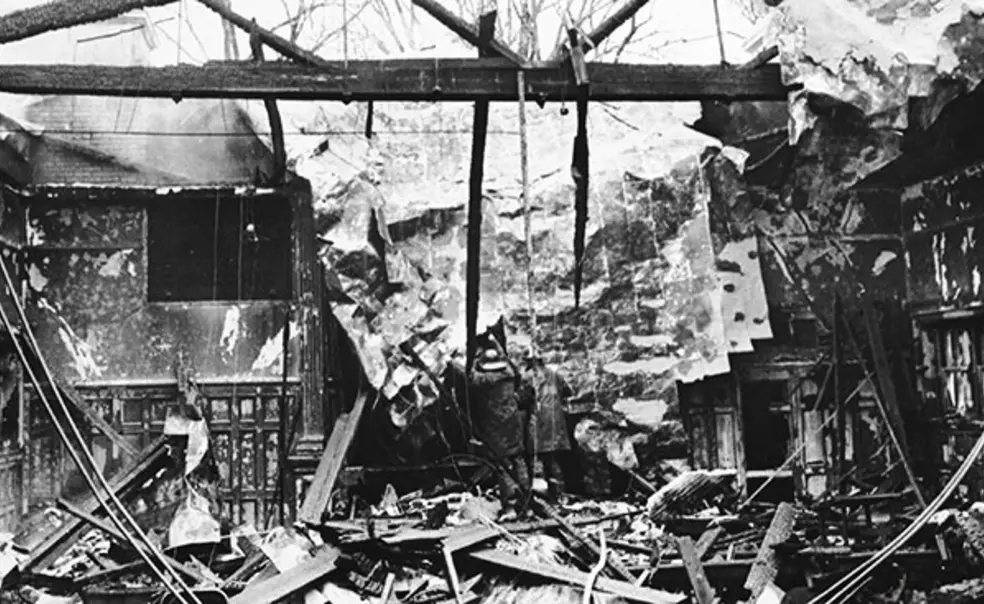Fire has taken a toll on Princeton’s campus, most notably in 1802 and 1855, when Nassau Hall was gutted. The first half of the 20th century was inauspicious, with flames consuming Marquand Chapel and Dickinson Hall in 1920, the John C. Green School of Science in 1928, and the University Gymnasium in 1944, but only one major conflagration has occurred since then: the destruction of Whig Hall on Nov. 9, 1969.
The neoclassical edifice and its sister, Clio Hall, had graced the University’s architectural landscape since 1893, replacing similar structures erected in 1838. But around 5:30 a.m., proctors discovered a blaze that would reduce the home of the American Whig-Cliosophic Society to a roofless shell.
Although the fire was blamed on “human carelessness” — likely a cigarette — the editors of The Daily Princetonian also reproached the University for not doing more to safeguard the building, noting, “The smoke sensors now being installed in dormitories did not exist in Whig Hall. ... Only fire extinguishers — helpful only in the smallest blazes — were provided.”
Officers made a valiant attempt to combat the fire in this way, but it took the efforts of three fire departments to quench the flames, which at their most intense shot 20 feet into the air. Mercifully, no one was injured, and according to the Prince, firefighters managed to remove “about 25 paintings, six typewriters, an Addressograph machine, and 26 captain’s chairs.” But “several choice paintings, a movie projector, a color television set, and the Society’s new $400 pool table” were lost.
The reconstruction of Whig Hall took three years and proved contentious, both in terms of its insurance valuation and architectural design. Recognizing that the cost of replicating its richly ornamented interior would be prohibitive, Whig-Clio President Christopher G. Lee ’70 predicted the building would feature “a charming mixture of concrete and plastic,” but even the prescient could not have guessed its future sobriquet, the “Yellow Submarine” — a nod to the color of many of its doors and their porthole-like openings.
John S. Weeren is founding director of Princeton Writes and a former assistant University archivist.












3 Responses
William McDermott ’71
8 Years AgoFires on Campus
PAW says that on the Princeton campus “only one major conflagration has occurred since [1944], the destruction of Whig Hall on Nov. 9, 1969” (That Was Then, Nov. 8). Those who witnessed the Little Hall fire on Oct. 27, 1968, might beg to differ. Little’s footprint of destruction was of the same order of magnitude as Whig’s. Two of the dormitory’s entries were gutted. Two others received extensive water damage. Dozens of students were displaced and their belongings destroyed.
No doubt Whig was the more architecturally significant building. And the destruction of its interior was also complete. (But there was to be no restoration. Whig’s hollowed shell became a modernist playground.) Little was a dorm, whose outer walls were just another stone stretch of University Gothic and whose interior probably needed renovation anyway.
The Whig fire took place in the middle of the night, while most of the campus slept. Little’s provided hundreds with a couple of hours of fiery spectacle on an otherwise dull Sunday afternoon. (It soon became obvious that no one had been killed or injured, so there was no guilt about being entertained, as many were. Spectators were serenaded by a stereo blasting the Doors’ “Light My Fire” from an open window in Laughlin Hall.) That, along with its direct impact on the lives of many students, made it the more communal experience.
It certainly merits inclusion in any discussion of “major” fires in the small world that is Princeton.
Jim O’Donnell ’72
7 Years AgoBringing Safety to Campus
Bill McDermott ’71’s letter on the Little Hall fire of 1968 (Inbox, Jan. 10) merits a footnote. When classes resumed in the fall of 1969, the campus saw many changes, most visibly the presence of women undergraduates. But as the year began, Princeton was also completing a $550,000 project to install smoke detectors — the first many of us had ever seen or even heard of anywhere — in all the dorms. The technology was new, needed calibrating, and not quite ready for prime time in dorm life; it took a while for the situation to stabilize. The Oct. 21, 1969, issue of PAW reported on a bad weekend when 24 separate false alarms required evacuations and investigations. Three weeks later PAW reported the predawn fire at Whig Hall, where there were no smoke detectors as yet, suggesting possible careless smoking as the cause.
Unhappy events, happily without injuries, but a reminder of a time when campuses became more aggressive in promoting the physical safety and security of students. (The women’s entries of Pyne Hall had the first locked doors of any dormitory entrances on campus.)
Charles Scribner III ’73 *77
8 Years AgoFires on Campus
Architect Charles Gwathmey’s brilliant solution to the fire-gutted Whig Hall is an emblem of Princeton’s inspired tradition of merging old and new, a feature that makes its campus the most inviting and inventive of all. I am reminded of all those fortuitous fires in the Middle Ages that gave rise to new Gothic cathedrals — and of course the Great Fire of London that cleared the way for Wren’s St Paul’s! Onward.